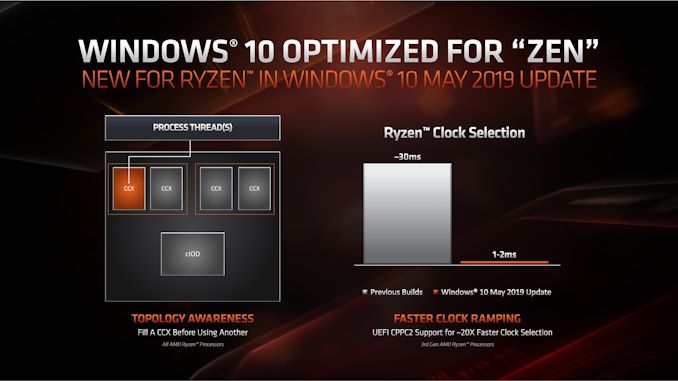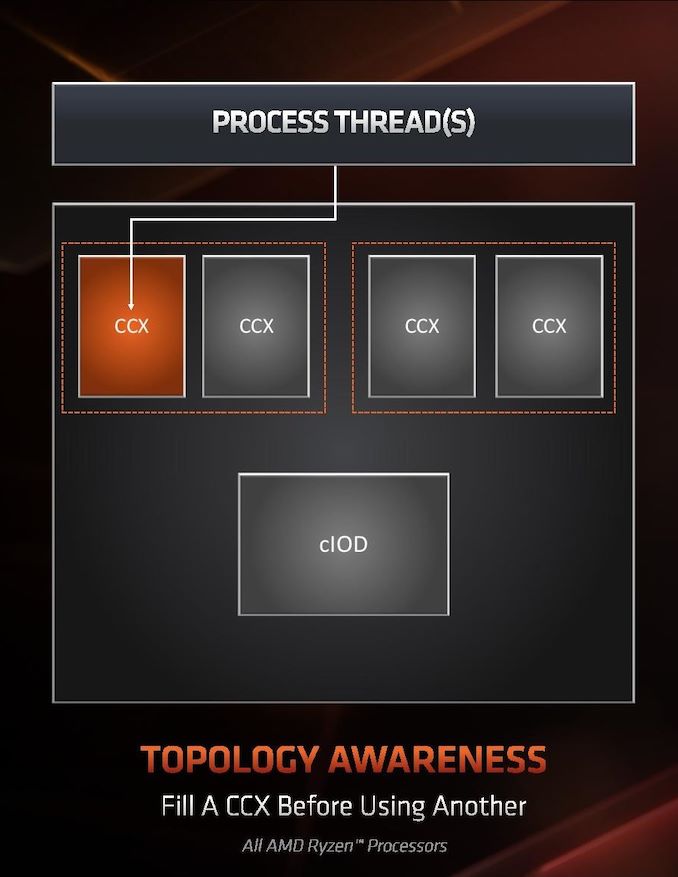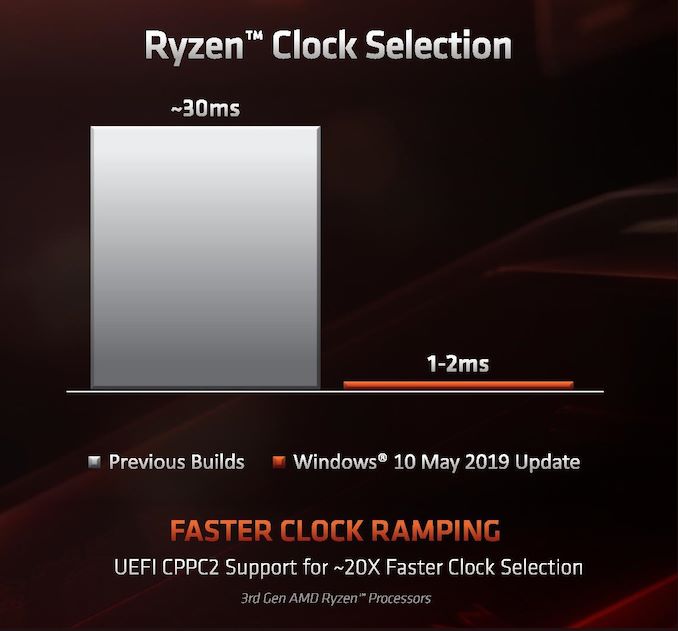The AMD 3rd Gen Ryzen Deep Dive Review: 3700X and 3900X Raising The Bar
by Andrei Frumusanu & Gavin Bonshor on July 7, 2019 9:00 AM ESTSection by Dr. Ian Cutress (Orignal article)
Windows Optimizations
One of the key points that have been a pain in the side of non-Intel processors using Windows has been the optimizations and scheduler arrangements in the operating system. We’ve seen in the past how Windows has not been kind to non-Intel microarchitecture layouts, such as AMD’s previous module design in Bulldozer, the Qualcomm hybrid CPU strategy with Windows on Snapdragon, and more recently with multi-die arrangements on Threadripper that introduce different memory latency domains into consumer computing.
Obviously AMD has a close relationship with Microsoft when it comes down to identifying a non-regular core topology with a processor, and the two companies work towards ensuring that thread and memory assignments, absent of program driven direction, attempt to make the most out of the system. With the May 10th update to Windows, some additional features have been put in place to get the most out of the upcoming Zen 2 microarchitecture and Ryzen 3000 silicon layouts.
The optimizations come on two fronts, both of which are reasonably easy to explain.
Thread Grouping
The first is thread allocation. When a processor has different ‘groups’ of CPU cores, there are different ways in which threads are allocated, all of which have pros and cons. The two extremes for thread allocation come down to thread grouping and thread expansion.
Thread grouping is where as new threads are spawned, they will be allocated onto cores directly next to cores that already have threads. This keeps the threads close together, for thread-to-thread communication, however it can create regions of high power density, especially when there are many cores on the processor but only a couple are active.
Thread expansion is where cores are placed as far away from each other as possible. In AMD’s case, this would mean a second thread spawning on a different chiplet, or a different core complex/CCX, as far away as possible. This allows the CPU to maintain high performance by not having regions of high power density, typically providing the best turbo performance across multiple threads.
The danger of thread expansion is when a program spawns two threads that end up on different sides of the CPU. In Threadripper, this could even mean that the second thread was on a part of the CPU that had a long memory latency, causing an imbalance in the potential performance between the two threads, even though the cores those threads were on would have been at the higher turbo frequency.
Because of how modern software, and in particular video games, are now spawning multiple threads rather than relying on a single thread, and those threads need to talk to each other, AMD is moving from a hybrid thread expansion technique to a thread grouping technique. This means that one CCX will fill up with threads before another CCX is even accessed. AMD believes that despite the potential for high power density within a chiplet, while the other might be inactive, is still worth it for overall performance.
For Matisse, this should afford a nice improvement for limited thread scenarios, and on the face of the technology, gaming. It will be interesting to see how much of an affect this has on the upcoming EPYC Rome CPUs or future Threadripper designs. The single benchmark AMD provided in its explanation was Rocket League at 1080p Low, which reported a +15% frame rate gain.
Clock Ramping
For any of our users familiar with our Skylake microarchitecture deep dive, you may remember that Intel introduced a new feature called Speed Shift that enabled the processor to adjust between different P-states more freely, as well as ramping from idle to load very quickly – from 100 ms to 40ms in the first version in Skylake, then down to 15 ms with Kaby Lake. It did this by handing P-state control back from the OS to the processor, which reacted based on instruction throughput and request. With Zen 2, AMD is now enabling the same feature.
AMD already has sufficiently more granularity in its frequency adjustments over Intel, allowing for 25 MHz differences rather than 100 MHz differences, however enabling a faster ramp-to-load frequency jump is going to help AMD when it comes to very burst-driven workloads, such as WebXPRT (Intel’s favorite for this sort of demonstration). According to AMD, the way that this has been implemented with Zen 2 will require BIOS updates as well as moving to the Windows May 10th update, but it will reduce frequency ramping from ~30 milliseconds on Zen to ~1-2 milliseconds on Zen 2. It should be noted that this is much faster than the numbers Intel tends to provide.
The technical name for AMD’s implementation involves CPPC2, or Collaborative Power Performance Control 2, and AMD’s metrics state that this can increase burst workloads and also application loading. AMD cites a +6% performance gain in application launch times using PCMark10’s app launch sub-test.
Hardened Security for Zen 2
Another aspect to Zen 2 is AMD’s approach to heightened security requirements of modern processors. As has been reported, a good number of the recent array of side channel exploits do not affect AMD processors, primarily because of how AMD manages its TLB buffers that have always required additional security checks before most of this became an issue. Nonetheless, for the issues to which AMD is vulnerable, it has implemented a full hardware-based security platform for them.
The change here comes for the Speculative Store Bypass, known as Spectre v4, which AMD now has additional hardware to work in conjunction with the OS or virtual memory managers such as hypervisors in order to control. AMD doesn’t expect any performance change from these updates. Newer issues such as Foreshadow and Zombieload do not affect AMD processors.














447 Comments
View All Comments
tamalero - Monday, July 8, 2019 - link
Because you're testing the CPUs not the video cards you clown.529th - Monday, July 8, 2019 - link
Anyone know how well one chiplet Overclocks VS a 2 chiplet? I'm thinking one chiplet would not be as limited by temps verse a 2 chiplet.acme64 - Monday, July 8, 2019 - link
Is there any word on a performance difference while on x470 vs x570?haukionkannel - Tuesday, July 9, 2019 - link
There is not difference. Even 350 motherboard works with 12 core 3900. There was one test that did that.CaedenV - Monday, July 8, 2019 - link
*Slow clap*Great work AMD!
I have always been a snobbish Intel user. Back in the late '90s and early '00s it was because the audio software I used simply was not stable on AMD (heck, it was barely stable on Intel lol). Then after the Core2 came out Intel was weirdly the best AND the cheapest for a very long time. But now, AMD really has a lot going for itself, and I am truly impressed.
Hoping to rebuild my aging (but still pretty great) i7 2600 this fall... mostly because I need it as a home server, not really because I 'need' an upgrade. But I think I am going AMD this time around. I really can't believe how much they have improved in the last 3 years!
GreenReaper - Monday, July 8, 2019 - link
Guys... I get you might not want to adjust your testing base. But MDS/Zombieload makes a significant difference when it comes to system calls, such as just about any file or network access.https://www.phoronix.com/scan.php?page=article&...
The reason for this is that the CPU has to perform a crazy sequence of events when accessing privileged data when two threads on a core are involved, essentially yanking the other thread into kernel mode as well, performing the privileged access that the original thread wanted, then flushing all relevant buffers before returning the two threads, so that the other thread can't run a timing attack using data from them.
It's a hack, and the impact is potentially worse the more modern the Intel CPU is, because - aside from the Atom - they have had increasingly bigger output buffers, especially Skylake+.
The OS fixes were out in mid-May when Zombieload was announced, for both Windows and Linux, so I don't know where you're getting "the patches for that have not been released yet".
Maybe you're thinking firmware for your motherboard to load new microcode? This is typically more of an issue for Windows; on Linux you'd just load the appropriate package. But even here, this doesn't make sense, because (for example) your Z370 i7 Gaming (used for the critical Intel 8/9th Gen CPUs) *does* have a newer BIOS:
https://www.asrock.com/MB/Intel/Fatal1ty%20Z370%20...
In fact, much newer. The 4.00 is from May 13, so presumably is relevant to MDS. You seem to be on 1.70, from March 26... 2018. There have been five updates since then. Why was it not updated?
zealvix - Tuesday, July 9, 2019 - link
Yea, saw several articles from other sites that both microcode update from Intel and OS patches from Microsoft have been released.CityBlue - Tuesday, July 9, 2019 - link
I quickly scanned the comments to see if the benchmarks had been performed with all relevant mitigations installed and was not surprised in the least to discover they hadn't, so frankly this entire article is pointless and I won't waste my time reading it. All there is left to say about this article is that whatever difference Anadtech determined between Intel and AMD, it would have been even more in favor of AMD had all Intel mitigations been enabled.Anandtech, Ryan Smith etc., do yourself a favor and re-test your Intel CPUs with *all* mitigations enabled otherwise your Intel benchmarks are just a sham, and you will start to lack credibility. Based on the comments for this article and others your readership are already staying to lose faith in your integrity. Other sites such a phoronix.com are doing a great job detailing the full impact of the mitigations (including Zombieload which you should have tested) so it's hard to take serially your reasons for not testing with a level, real-world playing field (ie. full mitigations). Or maybe you just didn't want to give out a Gold award? :)
TEAMSWITCHER - Tuesday, July 9, 2019 - link
Really getting tired of comments like this. They should just delete them.CityBlue - Tuesday, July 9, 2019 - link
@TEAMSWITCHER For people that aren't Intel apologists, this stuff matters. Not just because we as consumers want to get an honest review of how the latest AMD hardware stacks up against Intel in a real world situation with all mitigations applied, but also because this elephant in the room is a core credibility issue that Anandtech need to deal with.